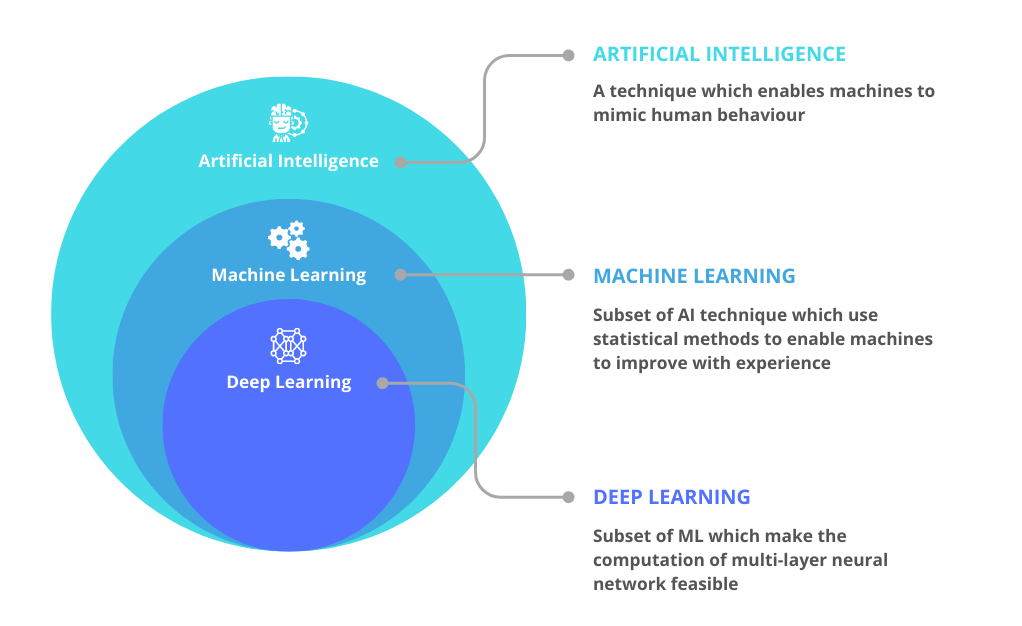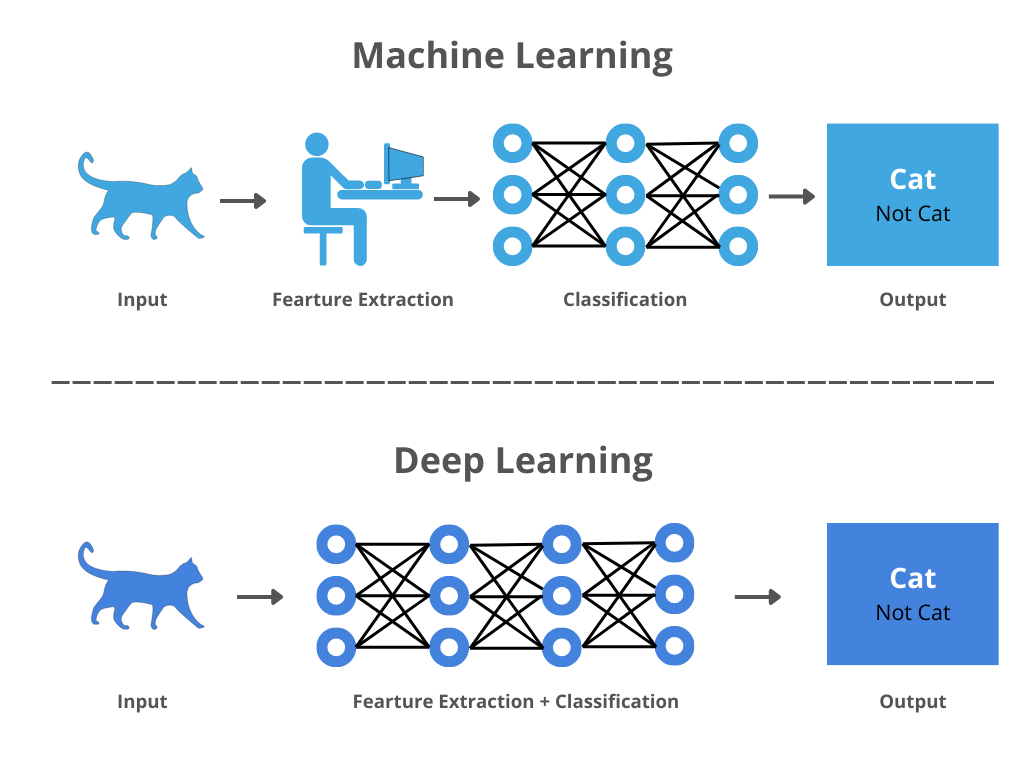In the ever-evolving landscape of artificial intelligence (AI), two powerful and interrelated fields have emerged: deep learning and machine learning. While these terms are often used interchangeably, they represent distinct approaches to solving complex problems and extracting meaningful insights from data.
In this article, we delve into the differences between deep learning and machine learning, shedding light on their unique characteristics, architectures, and applications.
What is Machine Learning?
Machine learning (ML) is a subset of artificial intelligence that focuses on the development of algorithms and statistical models that enable computers to learn from and make predictions or decisions based on data.
In essence, machine learning empowers computers to improve their performance on a task through experience without being explicitly programmed for every possible scenario.
The core idea behind machine learning is to enable computers to recognize patterns, relationships, and trends within datasets and then use this acquired knowledge to generalize and make informed decisions when presented with new data.
Key Concepts in Machine Learning:
- Data: ML relies on data, including pictures, numbers, etc. — anything we want the computer to learn from. This data has features (details) and outcomes (what we want to know).
- Features: These are the details in the data that the computer looks at to make decisions. If we're talking about pictures of animals, features could be things like colors and shapes.
- Algorithms: These are like the problem-solving rules that the computer follows to learn from the data. There are different algorithms for different tasks.
- Training: We use the data to teach the computer by adjusting its 'thinking' based on the outcomes we want.
- Testing and Validation: Once the computer learns, we check how well it's doing with new data it hasn't seen before.
- Predictions: After learning, the computer can tell us things about new data, like whether a new picture is a cat or a dog.
Machine learning manifests in varied paradigms, including supervised learning with guided instruction, unsupervised learning that uncovers latent patterns, and reinforcement learning based on rewards or penalties.
So, machine learning is like teaching a computer to think for itself by showing it lots of examples and helping it figure out the important stuff. It's kind of like training a dog – you show it what's right, and it learns to do the right thing on its own.
Check out a related article:
Artificial Intelligence in a Nutshell: Types, Principles, and History
What is Deep Learning?
Deep learning is a specialized subfield of machine learning that focuses on training artificial neural networks to automatically learn and extract intricate features and patterns from data.
It is inspired by the structure and functioning of the human brain's neural networks, aiming to simulate the process of learning and abstraction in a computational model.
Key Concepts in Deep Learning:
- Neural Networks: Imagine a network of brain-like nodes. Each node processes info and passes it along. These layers of nodes help computers learn and make sense of data. The "deep" part comes from having lots of these layers.
- Deep Structures: Deep learning loves complexity. It uses many layers to understand data step by step, from basic to super complex. This helps it uncover deep connections and patterns.
- Training: Deep learning needs practice. It learns from loads of labeled data. Think of it as adjusting its inner workings to get predictions as close to real answers as possible.
- Activation Magic: Neurons use activation tricks (functions) to deal with complicated stuff. They help the network capture tricky relationships in data.
- Learning Features: A cool thing about deep learning is that it doesn't need humans to identify which features are important. In deep learning, the computer figures that out on its own, unlike regular machine learning.
- CNNs and RNNs: Deep learning has special tricks like Convolutional Neural Networks (CNNs) for images, which can spot patterns like edges, and Recurrent Neural Networks (RNNs) for sequences, which are great for speech and languages.
So, deep learning is like a brain workout for computers. It helps them learn complex patterns from data and do awesome things like recognize images, understand languages, and more.

Working Principles of Machine Learning and Deep Learning
Let's break down the difference in how machine learning and deep learning work using the simple example of differentiating between pictures of cats and dogs:
Machine Learning:
- Collect and Prepare: Get lots of pictures of cats and dogs, and label each picture as a cat or a dog.
- Figure out Important Stuff: Look at things like colors and textures in the pictures to decide what makes a cat different from a dog.
- Choose a Smart Friend: Pick a machine learning tool (algorithm) that can learn from the pictures.
- Teach and Learn: Show the tool the labeled pictures, and tell it what's special about each one. It learns by finding patterns in the pictures.
- Check the Report Card: Test the tool with new pictures it hasn't seen before. See how well it can tell cats from dogs.
- Make It Even Smarter: If the tool doesn't do super well, tweak its settings and try again to make it better.
Deep Learning:
- Gather Pictures: Get loads of pictures of cats and dogs with their labels.
- Develop Brainy Network: Create a special brain-like network with different layers that can learn independently.
- Train It: Show the network the pictures and labels so it can learn the difference between a cat and a dog.
- Test Its Skills: Give the network new pictures to see if it can tell cats from dogs correctly.
- Perfect It: If it's not perfect, adjust the network and try more pictures to help it do better.
So, machine learning uses smart tools to learn from labeled pictures, while deep learning creates a clever network that learns by itself. Both ways help computers recognize things like cats and dogs in pictures!

In summary, the fundamental difference lies in how features are extracted and processed: machine learning relies on manual feature engineering, while deep learning leverages automatic feature learning through neural networks, making it more suitable for complex tasks like image recognition.
Check out a related article:
The Future is Now: Key AI Development Trends for 2023
Use Purposes: Choosing Between Machine Learning and Deep Learning
Deciding whether to use machine learning (ML) or deep learning (DL) depends on various factors. Let's break down the key differences:
Machine Learning (ML):
- When Data is Limited: ML is a good choice when you don't have tons of data. It's more efficient when you don't need to find really complex patterns.
- Simple Tasks: For tasks that don't need super detailed understanding, like predicting prices based on a few factors, ML works fine.
- Interpretable Results: If you need to understand why a decision was made, ML might be better. It gives you more insight into how the model works.
Deep Learning (DL):
- Big Data, Complex Patterns: When you're dealing with massive amounts of data and need to find intricate patterns (like in images, language, or sounds), DL is the champ.
- High Accuracy Needed: For tasks that require top-notch accuracy, like image recognition or language translation, DL is your go-to.
- Automating Feature Learning: If you want the computer to automatically learn the most important stuff from raw data (like pixels in an image), DL is the wizard.
But it's not always one or the other. Sometimes a mix of both can work wonders.
Conclusion
In the ever-evolving realm of artificial intelligence, two influential fields have emerged: deep learning and machine learning. These approaches, while often used interchangeably, offer distinct methodologies for solving intricate problems and extracting valuable insights from data.
Here’s a short recap of the ML and DL features described in the article above to help you navigate even more quickly:
| Parameter | Machine Learning | Deep Learning |
|---|---|---|
| Data Dependency | Works with smaller data, but needs more for better performance. | Relies on large amounts of data for good performance. |
| Execution time | Faster training, longer testing. | Longer training, faster testing. |
| Hardware Dependencies | Works on low-end machines. | Requires GPUs and high-end machines. |
| Feature Engineering | Needs manual feature extraction. | Learns high-level features from data. |
| Problem-solving approach | Breaks problem into sub-parts. | Follows end-to-end approach. |
| Interpretation of result | Easy to interpret results. | Difficult to interpret results. |
| Type of data | Mostly structured data. | Handles both structured and unstructured data. |
| Suitable for | Simple to somewhat complex problems. | Complex problems. |
As AI continues its rapid evolution, both deep learning and machine learning solutions remain powerful tools, each possessing distinct strengths and capabilities. If you're considering implementing any of these technologies in your business, look no further. Our team of experts is here to guide you through the process and help you leverage the power of AI for your success.
Leave a Comment